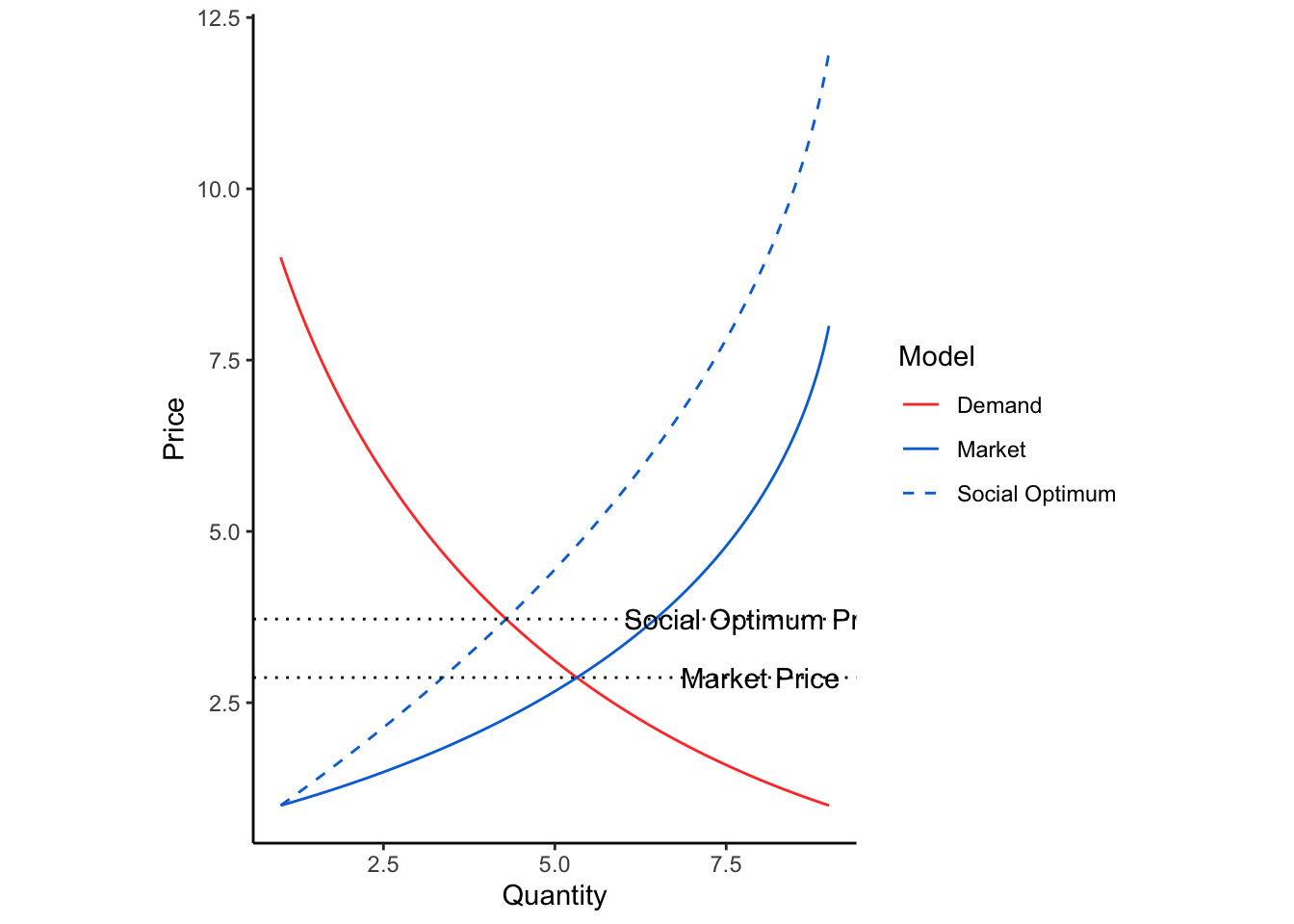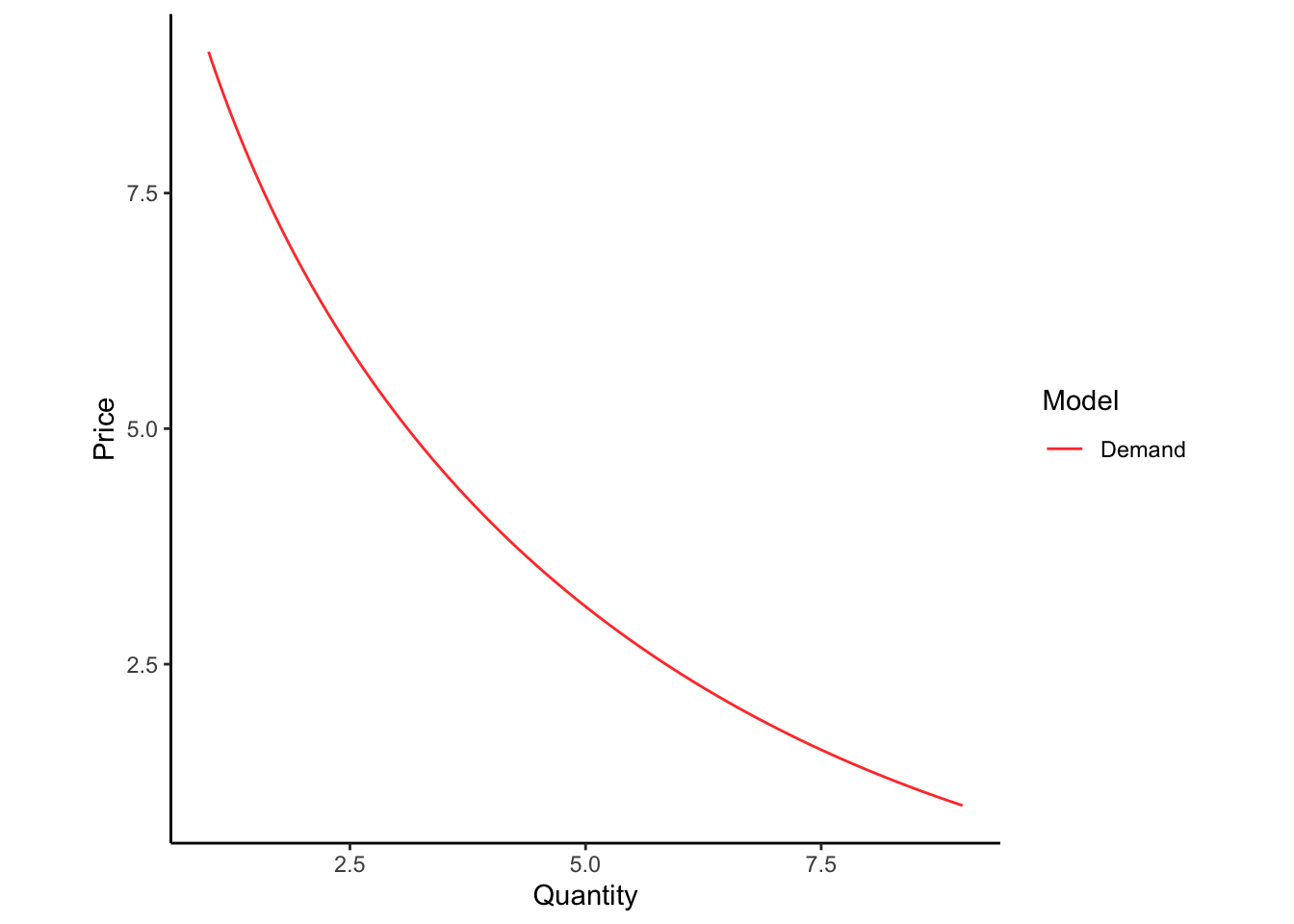
3 Economics
You buy lots of things. From the shoes to your feet to the mask on your face, almost everything you can see or touch was purchased. If not by yourself, than by someone else. Some things you buy and then own. Other things you pay a fee to rent. Other things are services or experiences that you can buy.
You will also sell lots of things throughout your life. Obviously if you are in a trade that produces goods, you will sell those goods. There will also be occasions where you will sell something you are no longer using, be it a tennis racket at a yard sale, or a car you have replaced, or a home you no longer live in. But as an engineer the thing you will sell most frequently is your knowledge and skills through your labor. Someone will pay you for expertise and time that they do not have, and in exchange you will buy the things you and your family and your business need to keep going.
The sum total of all of these buying and selling transactions in a society is called the Economy, and economics is the branch of social science that studies these transactions. This chapter consists of lectures on wider economic principles. Note that information about “Engineering Economics” is contained in Chapter 4.
Looking at the world from a purely economic perspective — the idea that anything in this world can be purchased with sufficient funds — is at once true and supremely corrupting / discouraging. Money is a necessary evil of our world, and it (almost) always has been. But understanding how the economy works is necessary to succeed in life and help yourself and those around you overcome the world. Some teachings on money from the Savior:
And I say unto you, Make to yourselves friends of the mammon of unrighteousness; that, when ye fail, they may receive you into everlasting habitations. — Luke 16:91
Lay not up for yourselves treasures upon earth, where moth and rust doth corrupt, and where thieves break through and steal: But lay up for yourselves treasures in heaven, where neither moth nor rust doth corrupt, and where thieves do not break through nor steal: For where your treasure is, there will your heart be also. —Matthew 6:19-20
3.1 Supply and Demand
Let’s say people want to buy widgets. People will buy a certain number of them based on how much they cost. If the price is low, people will buy lots of widgets. If the price is high, people will not buy as many. This demand function \(P = D(Q)\) might look like this:
The slope of the demand line is related to a meaningful economic concept called the elasticity. Mathematically, elasticity is defined as the proportial change in the quantity demanded resulting from a proportional change in the price. The elasticity is not exactly the slope of the demand curve, because elasticity is defined in percent change, rather than rise over run.
\[ \varepsilon = \frac{\%\Delta Q}{\% \Delta p} \tag{3.1}\]
To calculate the proportional change in a quantity \(x\), you divide the difference between the two values by the initial or reference value:
\[ \%\Delta(x) = \frac{(x_2 - x_1)}{x_1} \tag{3.2}\]
So, a positive change from \(x_1=10\) to \(x_2 = 15\) is \((15-10) / 10 = 0.5\). In speech, people will usually convert this proportion to a percent change, saying “\(x\) grew by 50%.”
Some goods are elastic, meaning that a small change in price results in a large change in demand, (\(\varepsilon < -1\)). Other goods are inelastic, meaning that demand will remain more or less fixed as the price goes up (\(-1 < \varepsilon < 0\)). Goods where the demand actually increases at the price goes up (\(\varepsilon > 0\)) exist, but are very unusual.
Are there goods that you will buy no matter what the price is? For lots of people, things like milk, gasoline, and diapers fit in this category.
Somewhere else in the economy, there are people who make widgets. These people have exactly the opposite incentives as the people in the demand function. If the price of widgets is high, manufacturers will want to sell lots of them. If the price is low, then manufacturers will not make as many. This supply function \(P = S(Q)\) looks like this:
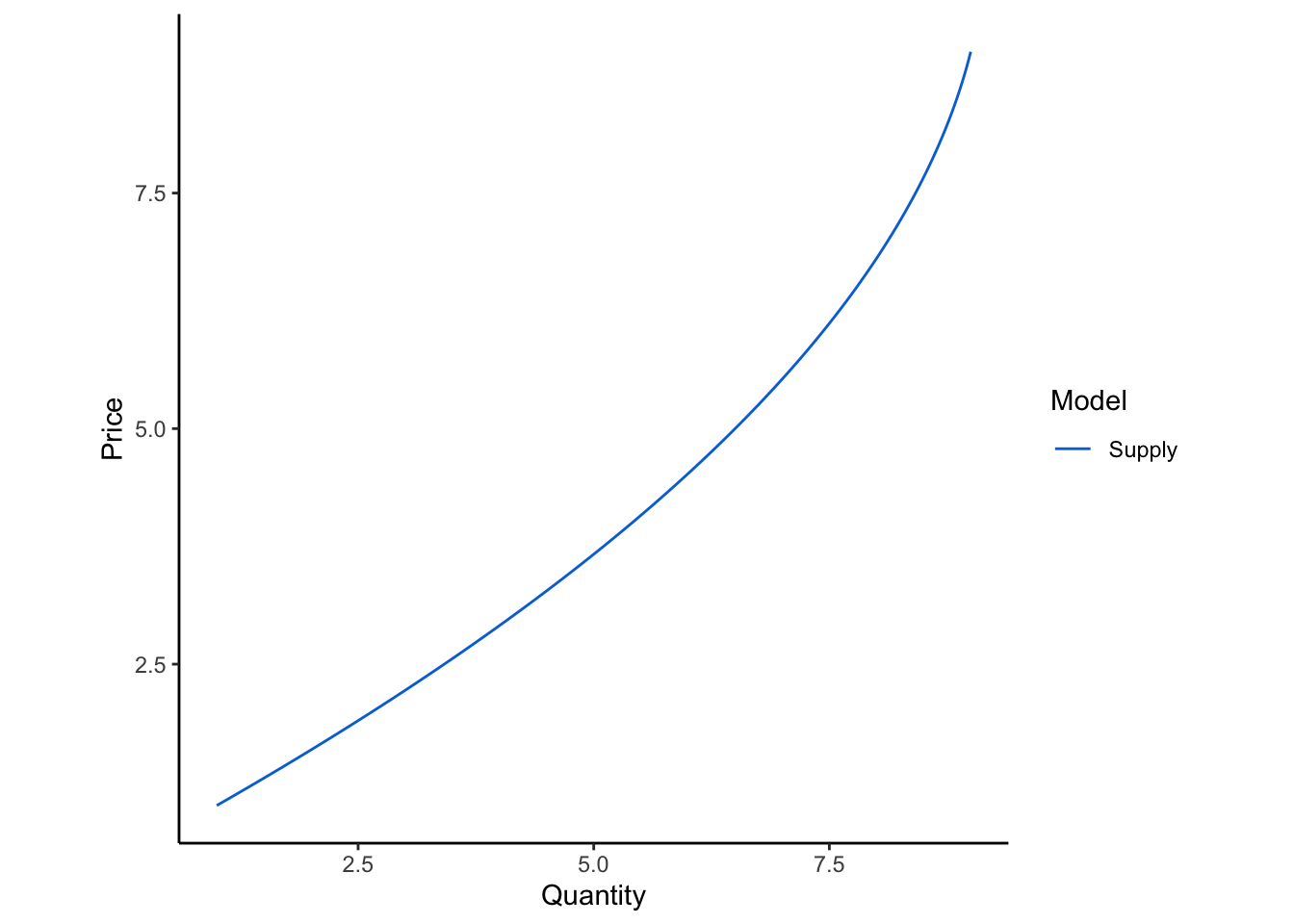
When we put both functions on the same plot, you can see that there is a particular price where the demand and supply curves intersect. If manufacturers set a higher price than this equilibrium point, they will make more widgets than people will buy. If manufacturers set a lower price point, they will run out of inventory and lose revenue. Note that this solution also sets the quantity of goods that should be manufactured or purchased.
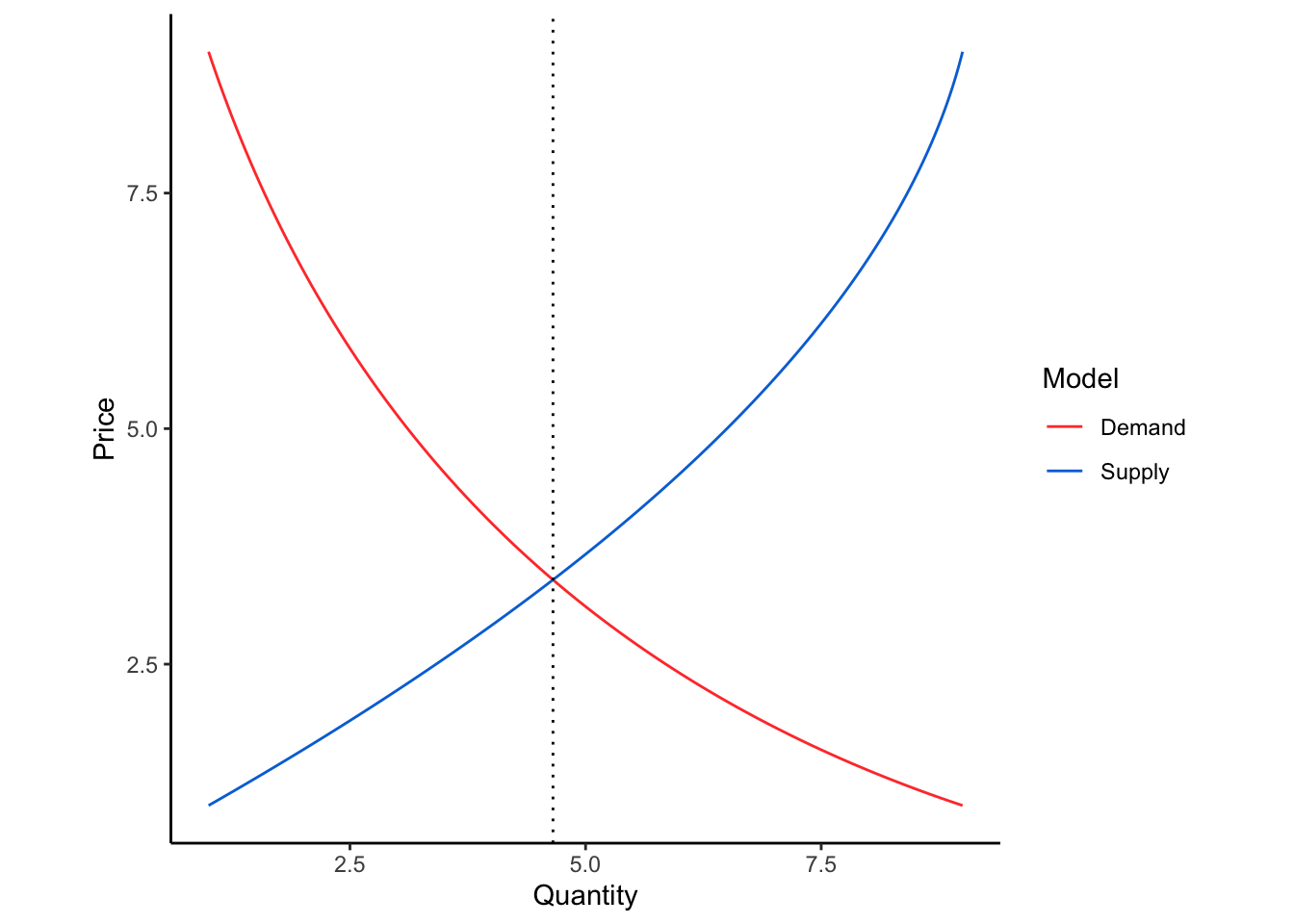
Finding the intersection of the supply and demand functions requires some simple algebra. You are looking for the solution \((Q, p)\) of the system of equations
\[ \begin{cases} p = S(Q) \\ p = D(Q) \end{cases} \tag{3.3}\]
This is most easily done by setting the difference of the functions equal to zero \(S(Q) - D(Q) = 0\) and then solving one of the other equations for \(p\).
Supply and demand functions change over time. Sometimes the reason is obvious, and sometimes it is not. If the population grows, then there will be more people who want to buy widgets. This will push the demand for widgets upwards. If nothing else changes in the supply function, then the price will rise and more widgets will be produced / purchased.
If the population grows by 10%, a simplifying assumption would be that the entire demand curve also increases by 10%, \(p = 1.1 * D(Q)\).
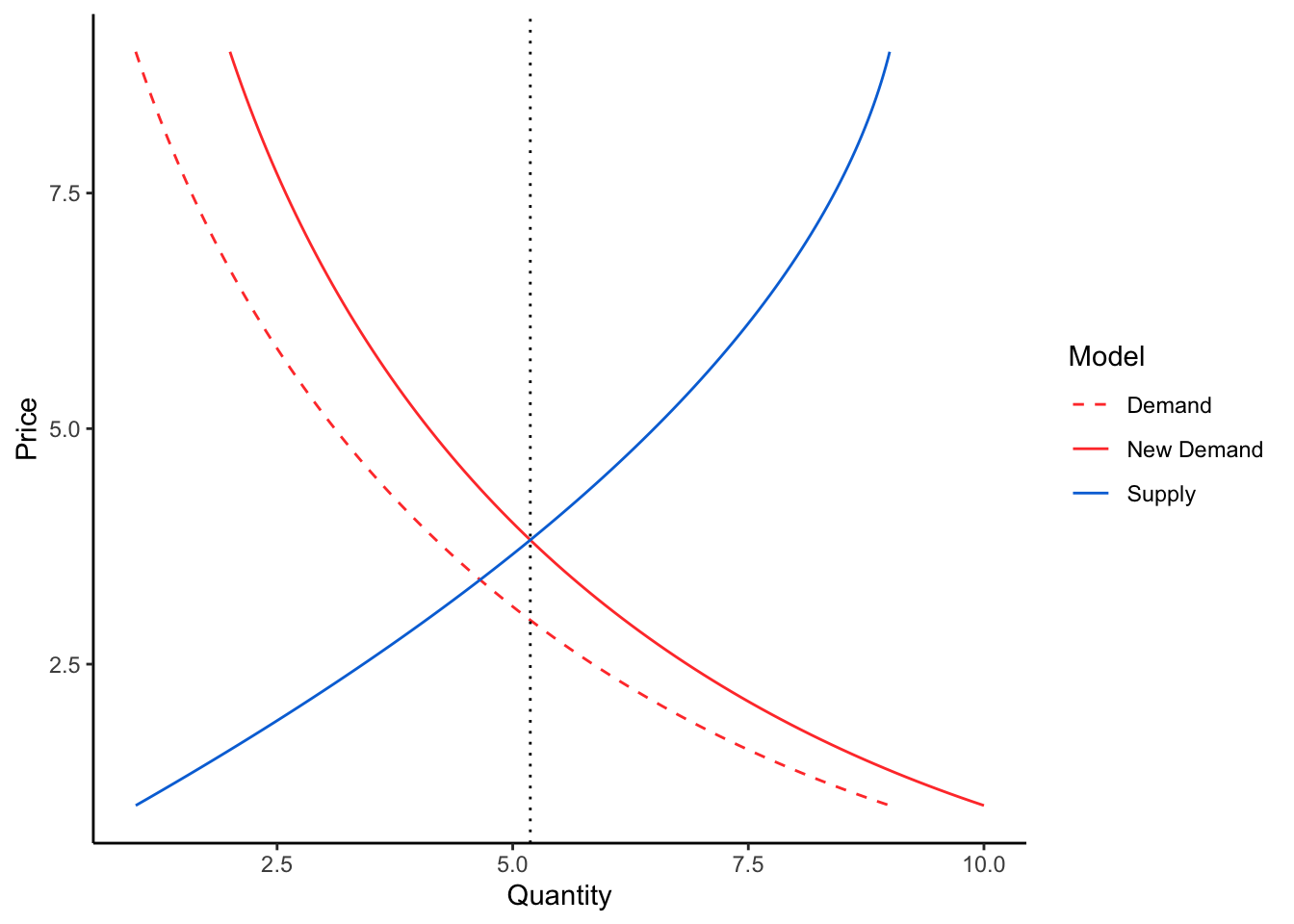
Sometimes the supply function will move up as well, meaning the system could reach the same equilibrium price for widgets as before. But often, the manufacturers have sufficient market power to increase supply while holding the price a little bit higher than before. This results in inflation, or the nominal price of goods creeping upwards. When wages increase to match price inflation, you have the tendency for currencies to lose purchasing power over time.
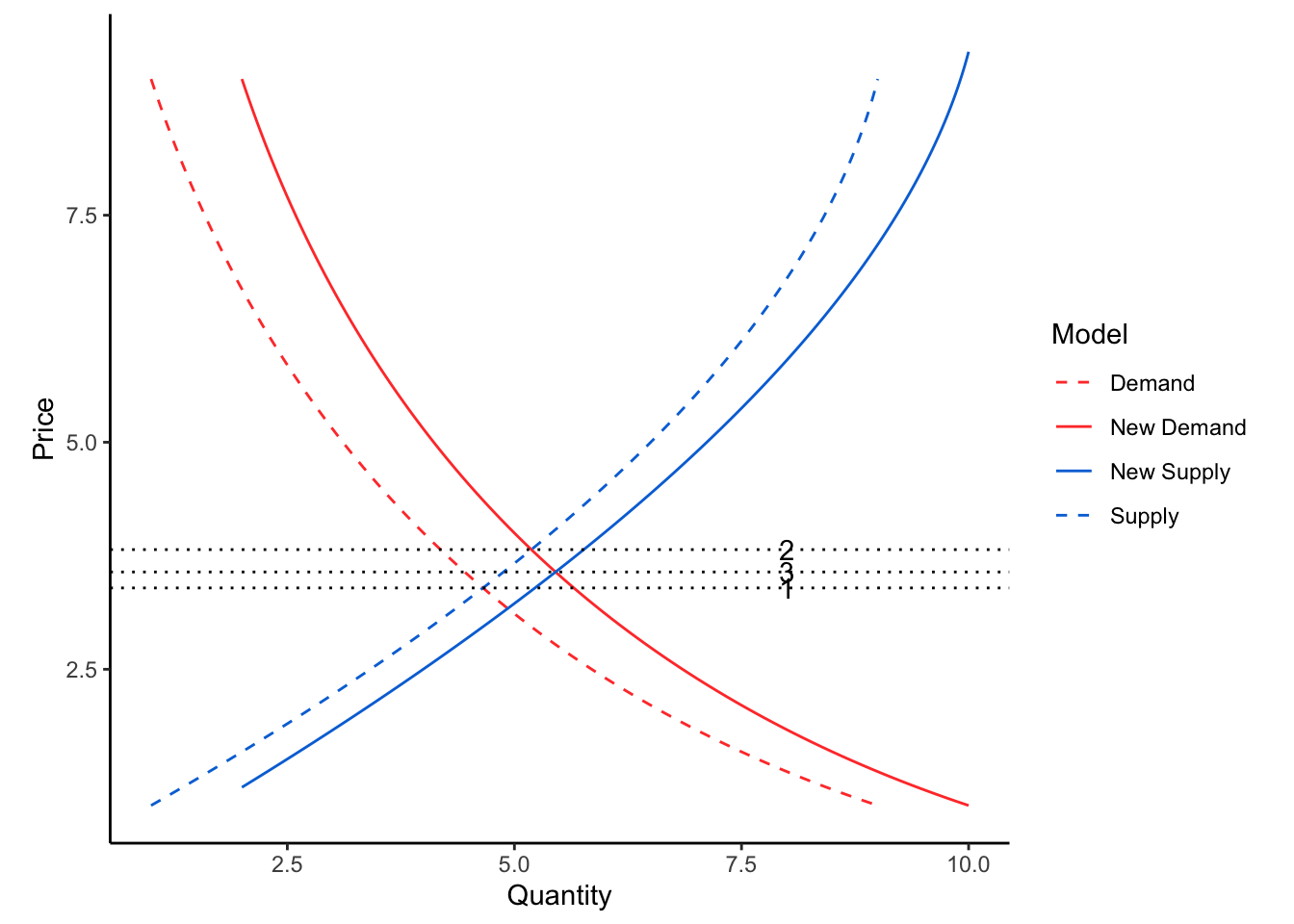
Inflation is often seen as a bad thing, because it means that a dollar you have now will not buy as much as in the future. But what happens when there is price deflation? Or what if inflation was exactly zero?
3.2 Comparative Advantage, Opportunity Cost, and Trade
Imagine you are in the custom home business, and you insist on designing and building every part of the home, foundation, framing, windows, drywall, plumbing, electricity, roof, carpentry, and so on. How successful do you think your business would be? Aside from taking a very long time to build the home, it would be a labor intensive way to build a home because you would need to spend time learning how to do each task (and making mistakes). Instead, you could have used expert builders, engineers, and craftsmen in their respective fields. By using the strengths of each craftsman, you can build a better home with fewer resources
Now imagine a scenario, where someone is worse at a job compared to another. Does it make sense for the two people to work together and specialize in different tasks? Or if one region is better at producing all products better than another region, would the regions have any incentive to trade with each other?
It turns out that even when one party has an absolute advantage over another party, there still is an incentive for them to specialize, work together and to trade. To understand this, we need to introduce the concepts of opportunity costs and comparative advantage. Opportunity cost is the value of the next best alternative that is given up when a choice is made (Copilot 2023; Dictionary 2024). Comparative advantage is when you can produce a good at a lower opportunity cost than someone else. It is society’s and your best interest to focus on producing goods where you have a comparative advantage.
Comparative advantage plays an important role in infrastructure, as it is the underlying process driving a great deal of the world’s transportation. Imagine a town with no transportation infrastructure: everything the town needs must be produced in the town. There will be lots of things that people in the town would want to buy, but there is no one with the time to produce it. But after builders and engineers connect the town to the world economy by building ports, roads, railroads, airports, warehouses, and everything else, the comparative advantage changes. Suddenly goods that were expensive to produce in the town can be imported for a lower cost. This means that people can buy the cheaper goods, and the person who used to make those goods will find a new area in which he or she holds a comparative advantage.
This same concept plays out in trading between regions and nations. The example below shows that both regions benefit when they produce the products for which they have an advantage and trade for the products for which they don’t have an advantage.
How does automation in manufacturing change an economy in the context of comparative advantage?
3.2.1 Globalization
The benefits of comparative advantage are a driving force for globalization (Hayes 2025). Globalization is the process by which economies and systems are becoming more interconnected, across geographical and political barriers. As transportation and communications infrastructure improves, countries and individuals are more able to pursue their comparative advantage. This means that on average, people will be more wealthy. But some people may not benefit as much as others.
3.2.2 Tariffs
One way that countries attempt to address the negative impacts of globalization is through the use of tariffs. Tariffs are taxes imposed on goods produced in other countries. Tariffs in general reduce economic growth while raising prices, but there may be other reasons to have them. Radcliffe (2025) lists five reasons why governments impose tariffs:
- Protect employment for certain sectors Research has shown that tariffs can protect employment in certain sectors, but there will be job losses in other sectors. For example, the US tariffs on Chinese steel and aluminum preserved jobs in the steel and aluminum industries, but it led to losses in exports as well as job losses in sectors that use steel and aluminum (Durante 2025).
- National security In the event of a crisis, it may be difficult if your primary source of raw materials is imports from your adversaries. Steel and microchip production are often cited as industries that should be protected for national security reasons.
- Protect consumers It may be that a government determines products made in another country pose risks to public health or safety but do not warrant a ban. A tarriff would encourage people to find cheaper — and presumably safer — substitutes.
- Protect developing industries As industries start, foreign competitors may have manufacturing cost advantages. Solar panel and electric vehicle companies in the United States might be viable in the future, but not if they are smothered in their infancy by cheap foreign imports.
- Retaliation Finally, governments use tariffs in retaliation for tariffs placed by other countries. After the US increased tariffs on Chinese steel, solar panels and aluminum, the Chinese government increased tariffs on US agricultural products including soybeans and cotton (Autor et al. 2024).
We invest billions of dollars building infrastructure to facilitate world trade, and then we subsequently implement tariffs to restrict trade. Why do we do this?
3.3 Public and Common Goods
A good in an economy is something that can be owned or consumed by people; these can be actual products, or they can be services. Goods can be classified based on two primary characteristics:
- Exclusivity: Can someone be effectively prevented from using a good if they did not pay for it?
- Rivalry: Does using a resource prevent others from using it? Or does using it diminish the experience of others.
These two characteristics form a matrix of four types of goods, shown in Figure Figure 3.2. Private goods are rivalrous and exclusive. Most goods in the economy are like this. A grocery store requires that people pay for food before leaving with them (exclusive), and food that is consumed by one person is not consumed by other people (rivalrous). Goods that are exclusive but not rivalrous are sometimes called “club” goods: streaming services and cable internet are usually unaffected by the number of people watching them, but you have to have paid a login to get them.
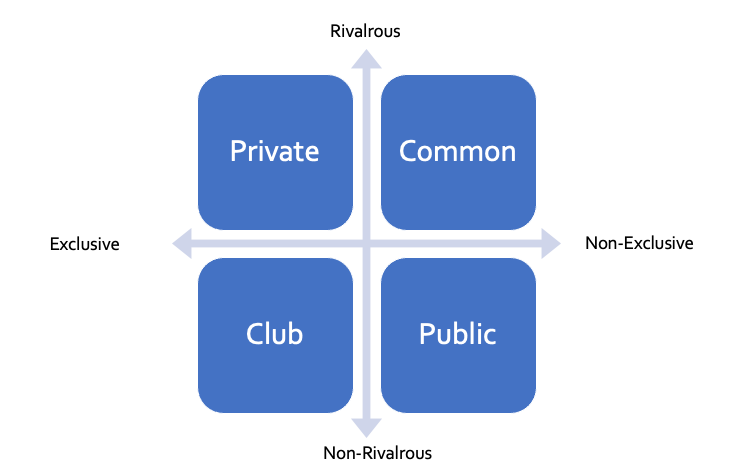
Public goods on the other hand are non-exclusive and non-rivalrous. A standard example of a public good is a light house. If you own a light house overlooking a harbor, there is no way for you to only allow ships that have paid a fee to see and use your light house (non-exclusive). If one ship is currently using your light house, other ships can use it at the same time (non-rivalrous). So if you own a light house, you probably need to find some other way to pay for your salary besides a subscription. In the United States, light houses are often operated by the Coast Guard as a public service.
In fact, much of the infrastructure in the United States is provided as a public good. Our lives are better and more prosperous because of this infrastructure, but it is sometimes hard to convince people to pay taxes to fund it.
Public goods are often owned by the public through governments, but not always. AM and FM radio and broadcast TV are all non-rivalrous and non-excludable. But just because they are public goods does not mean they are free; you pay to listen to the radio or watch TV by spending a good portion of your time in advertisements.
3.3.1 Tragedy of the Commons
Common goods are like public goods in that they are non-excludable. But common goods are rivalrous: not everyone can use the resource at the same time. Common goods can quickly become a sustainability issue. Usually, economists tend to believe that people following their own self-interest helps to set fair prices and encourages innovation and diversity in the economy. But if private interests encourage someone to over-use a common resource, then the resource could become degraded or disappear. This phenomenon — that private short-term interests conflict with long-term social interests — is called the tragedy of the commons.
The video below (or at this link) shows how the tragedy of the commons might play out in a village fishing pond; if people catch fish more quickly than they can regenerate, the pond will eventually have no fish. The public interest is in keeping the fish pond operating, but the private interest of each person is to catch as many fish as they can.
The Tragedy of the Commons can happen whenever private interests and public interests are in conflict. Examples or scenarios include the following:
- Fisheries in the North Atlantic depleted by overfishing
- Rain Forests destroyed for private agriculture
- Excessive lumber extraction from national forests
- Consuming irrigation water for high-water crops in California
Fixes for the Tragedy of the Commons usually require some kind of societal intervention. State fishing licenses limit the number of people who can fish, place catch limits on those who do, and provide resources for government enforcement and restocking efforts. Of course, knowing what interventions to install and how to shape them is a complicated problem.
Do we think of roads and streets as a private, common, or public good? Is this how they actually work? What are the consequences of this classification?
3.4 Externalities
Imagine you are riding your bicycle down a road when a large truck drives by “rolling coal”. As you inhale the noxious fumes, you suffer from this experience. And the truck drives on — perhaps oblivious to your coughing and perhaps not — without paying you anything for the costs his actions put on you.
It is common for the actions of one person to affect others. Sometimes these costs are captured within a market transaction, but other times they are not. Costs that are not captured within a transaction are called externalities because they are external to the transaction. When I put fuel in my gas tank and burn it, the market transaction is between me and the gas station / oil company. But everyone in the area breathes a little bit of my exhaust, and I’m not paying anyone to do that. Similarly, if I choose to stop buying gas and ride my bike, I still have to breathe the same polluted air as if I were driving.
So what can be done? In economic theory, the market sets the optimum cost of gasoline too low; the cost of pollution is not included in the transaction between the driver and the gas station. This means that there is some discrepancy between the market-established supply curve and a socially-optimal supply curve. If we implement a tax that moves the price of the from the the market price to the social optimum price, then the external costs can be captured and returned to the public.
Unit Summary
A good introductory resource on many of the topics in this unit is Khan Academy’s Microeconomics course.
- Economy The sum of all transactions in a society.
- Supply The function relating the price of a good with the quantity produced by manufacturers.
- Demand The function relating the price of a good with the quantity desired by consumers.
- Opportunity Cost The cost of forgoing the next-best alternative among multiple options.
- Utility The usefulness derived from purchasing goods and commodities; actors in the economy seek to maximize utility.
- Money A medium of exchange that facilitates transactions.
- Comparative Advantage A person’s or society’s ability to perform certain work more efficiently than another.
- Public Good A non-exclusive and non-rivalrous good.
- Common Good A non-exclusive but rivalrous good.
Homework
HW 1: Cement elasticity
Read this cement forecast for 2023, discuss why you think demand for cement is elastic or inelastic with respect to its price. Limit your response to 50 words.
HW 2: Elasticity
See the elasticity example above, near Equation 3.1. What would be the expected gallons per week of gas consumed if the gas price increased again to $3.15 and the elasticity remained the same?
HW 3: Supply and demand practice
Demand for a particular product can be described as \(D(Q)=1000 − Q\) and supply as \(S(Q)=200 + 5Q\) for prices between $200 and $1000.
- What is the equilibrium quantity and price demanded.
- Suppose that demand is expected to increase in proportion to population growth. What will be the equilibrium quantity and price in 10 years if the population grows by 10%?
- Suppose that over the same period, a new technology allows suppliers to cut their marginal costs to $3 per unit. That is, the supply function changes from \(S(Q)=200 + 5Q\) to \(S(Q)=200 + 3Q\). What is the new equilibrium quanity, and what is the new equilibrium price? (Assume that demand has also grown by 10%, as in part 2.)
HW 4: Nonlinear Supply and Demand
Assume the same price range of $200 to $1000, as in the problem above, but this time demand can be modeled as \(D(Q)=(-975(Q-1245))^{1/2}\) and supply as \(S(Q)=100*\ln(Q-150)/\ln(2)\). Make a rough sketch of the resulting graph, and solve for the equilibrium price and the quantity produced using a graphing calculator or other numerical / computer-based tool.
HW 5: Roads and the tragedy of the commons
Using the definition of a public good, are public roads a public good? Why or why not? What does this mean for highway infrastructure in the US?
HW 6: Air pollution and externalities
3One major element of air pollution is the concentration of particles in the atmosphere that are smaller than \(2.5\mu m\); when this concentration reaches more than \(35 \mu g / m^3\), breathing becomes hazardous for people with asthma or other respiratory conditions. Utah already regularly exceeds EPA minimum standards for particulate matter pollution. A primary contributor to particulate matter pollution is vehicles, through exhaust and also the microscopic pieces of rubber that rub off when tires roll on pavement.
- Consider that aggregate demand for vehicle travel can be represented with the function \(p = 0.89 * \exp(-0.04 * q)\) where \(p\) is the price of car travel per mile in dollars, and \(q\) is million vehicle miles traveled (MVMT). Consider that the supply function of gasoline, tires, insurance, etc. is given by the function \(p = 0.08 * \exp(0.06*q)\). Find the equilibrium price and quantity in dollars and MVMT.
- An analysis determines that to protect public health, aggregate VMT has to be reduced to at most 20 million. What tax on car travel per mile would accomplish this?
- Consider that by 2050, the population in Utah County is expected to double (\(D_{2050} = 2D_{2020}\)). What would be the equilibrium price and total VMT if the tax is not implemented?
- What would the VMT tax need to be to keep aggregate VMT under 20 million in 2050?
- Consider the global, economic, environmental, and social implications of the proposed VMT tax. Create a table categorizing who and what will benefit if Utah imposes the VMT tax, and who or what will benefit by not imposing the tax.
- Informed by the previous analysis, how do you propose that Utah County responsibly use the revenues generated by the VMT tax?
Alternative translations of this are very helpful for understanding the meaning. See, for instance BibleHub↩︎
Using a bit of multivariable calculus↩︎
This homework assignment is used to evaluate ABET Student Outcome 4.↩︎
